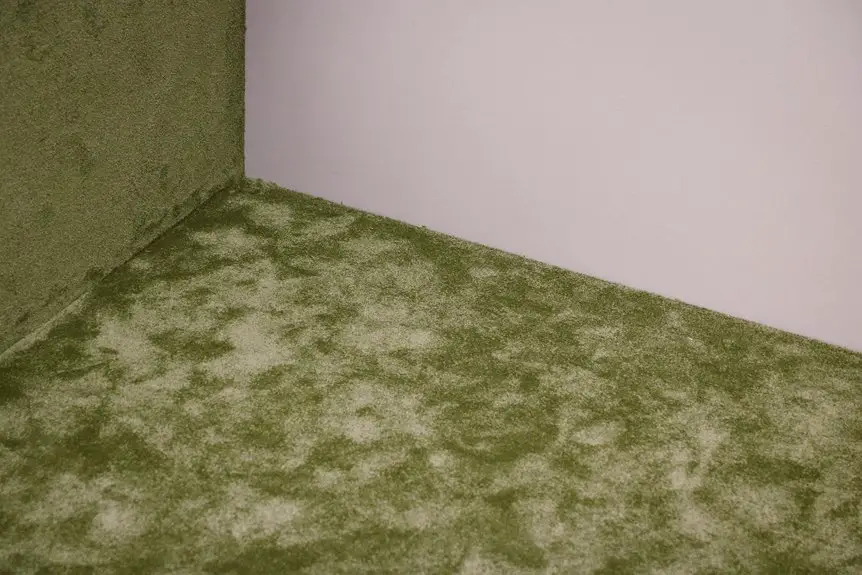To remove dried acrylic paint from upholstery, first identify your fabric type and test a cleaning solution like rubbing alcohol or diluted acetone on a hidden spot. Gently soften the paint by blotting the stain with your chosen cleaner, then use a dull scraper to lift excess paint without rubbing harshly. Follow by dabbing with mild detergent and warm water, then blot dry. For delicate fabrics, proceed cautiously. Keep going to discover detailed tips and preventive measures to protect your upholstery.
Table of Contents
Key Takeaways
- Test cleaning solutions on a hidden upholstery spot to prevent fabric damage before treating the paint stain.
- Gently scrape off excess dried paint using a dull knife or spoon without damaging the upholstery.
- Blot the stain with a cloth soaked in rubbing alcohol, acetone-based remover, or mild detergent solution to soften and lift paint.
- Rinse the area by dabbing with clean, cool water and blot dry with an absorbent towel to remove residue.
- Allow upholstery to air dry completely in a ventilated space and use drop cloths to prevent future acrylic paint stains.
Understanding Acrylic Paint and Upholstery Fabric
Acrylic paint is a fast-drying, water-based paint that bonds strongly to most surfaces, including upholstery fabric. When it dries, it forms a tough, waterproof layer that makes removal challenging.
You’ll find that it seeps into fabric fibers, especially on porous materials like cotton or linen, making stains stubborn. Synthetic fabrics like polyester may resist absorption slightly, but the paint still adheres firmly.
Understanding this helps you realize why quick action is essential for fresh spills. Once acrylic paint dries on upholstery, it becomes less soluble in water, so standard cleaning won’t work.
Knowing the paint’s composition and how it interacts with fabric fibers prepares you to tackle removal effectively. You’ll need targeted approaches that break down the paint without damaging your upholstery.
Assessing the Paint Stain and Fabric Type
Before you start cleaning, you need to carefully assess both the size and severity of the paint stain, as well as the type of upholstery fabric involved. A small spot might be easier to treat, while large or deeply set stains may require more effort or professional help.
Check if the paint has fully dried or if it’s partially tacky, as this affects removal methods.
Next, identify the fabric type by looking at the care tag or testing a hidden area. Natural fibers like cotton handle solvents differently than synthetics such as polyester.
Delicate materials like silk or velvet need extra caution to avoid damage. Knowing your fabric guarantees you choose the right cleaning approach and prevent further harm to your upholstery.
Gathering Supplies and Safety Precautions
Before you start, gather all the essential cleaning materials like a soft cloth, mild detergent, and rubbing alcohol.
Don’t forget to wear protective gloves and guarantee the area is well-ventilated to avoid inhaling fumes.
Setting up your workspace properly will keep you safe and make the process smoother.
Essential Cleaning Materials
Although removing dried paint can be challenging, having the right cleaning materials makes the process much easier and safer.
Start by gathering a plastic scraper or dull knife to gently lift paint flakes without damaging your upholstery. You’ll also need white cloths or paper towels for blotting. Keep a spray bottle filled with warm water handy to dampen the fabric during cleaning.
Have a mild detergent or dish soap ready to break down paint residues. For stubborn spots, isopropyl alcohol or a commercial acrylic paint remover can help, but test these on a hidden area first.
Don’t forget a small bowl for mixing solutions and gloves to protect your hands. With these essentials, you’ll tackle dried acrylic paint effectively while minimizing harm to your upholstery.
Protective Gear Recommendations
Handling cleaning agents like isopropyl alcohol or commercial paint removers means you should protect yourself properly.
Start by wearing nitrile gloves to shield your hands from harsh chemicals and prevent skin irritation. Use safety goggles to protect your eyes from splashes, especially when working with liquid removers.
It’s also a good idea to wear an old long-sleeved shirt or a protective apron to avoid staining your clothes. If you have sensitive skin or respiratory concerns, consider a mask, but since ventilation is vital, we’ll cover that next.
Avoid touching your face while cleaning and wash your hands thoroughly afterward. Taking these precautions guarantees your safety as you tackle dried acrylic paint on upholstery effectively and confidently.
Ventilation and Workspace Setup
Since strong fumes can build up quickly, you’ll want to set up your workspace in a well-ventilated area, like near an open window or outdoors if possible. This helps you avoid breathing in harmful chemicals while you remove dried acrylic paint from upholstery.
Before you start, gather all your supplies and make sure your workspace is safe and organized.
Here’s what you’ll need for an efficient setup:
- Open windows or doors for fresh air circulation
- A fan to help disperse fumes
- Protective gloves and goggles
- Old towels or drop cloths to protect surfaces
- A sturdy table or flat surface to place your cleaning materials
Setting up properly keeps you safe and makes the paint removal process smoother.
Testing Cleaning Solutions on a Hidden Area
Before applying any cleaning solution to the visible parts of your upholstery, you should test it on a hidden area first. This step helps you verify the cleaner won’t damage the fabric or cause discoloration.
Always test cleaning solutions on a hidden upholstery spot to prevent damage and discoloration.
Choose a spot that’s out of sight, like under a cushion or the back of the furniture. Apply a small amount of the solution and let it sit for about 10 minutes. Then, blot it gently with a clean cloth to check for any changes in color, texture, or fabric integrity.
If the fabric reacts poorly, try a different cleaning product or a milder mixture. Testing first protects your upholstery from unintended damage and saves you from bigger headaches later on.
Always prioritize safety before tackling the stain directly.
Softening the Dried Acrylic Paint
Once you’ve confirmed your cleaning solution is safe, you can focus on softening the dried acrylic paint to make removal easier.
Softening helps loosen the paint’s grip on the fabric fibers without damaging your upholstery. Here’s how to do it effectively:
- Dampen a clean cloth with warm water and apply your tested cleaning solution.
- Gently blot the paint stain to avoid spreading it further.
- Let the solution sit for 5-10 minutes to penetrate and soften the paint.
- Avoid rubbing aggressively, as this can damage the fabric.
- Repeat the process if the paint is particularly stubborn, ensuring the upholstery remains moist but not soaked.
Softening the paint prepares you for the next step: carefully removing excess paint without harming your upholstery.
Scraping Off Excess Paint Carefully
Start by gently scraping off the softened acrylic paint using a dull knife or a plastic scraper. Hold the tool at a low angle to avoid damaging the upholstery fibers.
Work slowly and carefully, lifting the paint away rather than pushing it deeper into the fabric. Remove only the loosened paint; stop if you encounter resistance to prevent tearing the material.
Use small, controlled strokes and avoid applying too much pressure. After each scrape, check the fabric to verify you’re not harming it. Dispose of the removed paint pieces promptly to keep your workspace clean.
This step prepares the upholstery for the next cleaning phase by eliminating as much dried paint as possible without compromising the fabric’s integrity.
Applying a Cleaning Solution for Acrylic Paint
Now that you’ve scraped off the excess paint, it’s time to choose a cleaning solution that works well on acrylic paint without damaging your upholstery.
You’ll want to apply it carefully to avoid spreading the stain or soaking the fabric too much.
Let’s explore the best products to use and how to apply them effectively.
Choosing Effective Cleaning Agents
Although dried acrylic paint can be stubborn, choosing the right cleaning agent will make the removal process much easier.
You want something that breaks down the paint without damaging your upholstery. Consider these effective options:
- Rubbing alcohol (isopropyl alcohol) for gentle but strong paint removal
- Dish soap mixed with warm water to loosen paint residue
- Acetone-based nail polish remover for tougher spots (test first!)
- Commercial upholstery cleaner designed for paint stains
- White vinegar for a natural, mild solvent alternative
Each agent works differently depending on your fabric type and paint thickness.
Before applying, always test a small hidden area to avoid discoloration or damage.
Picking the right solution sets you up for a smoother cleanup in the next steps.
Proper Application Techniques
Once you’ve chosen the right cleaning agent, applying it correctly can make a big difference in removing dried acrylic paint from your upholstery.
Begin by testing the solution on a hidden fabric area to verify it won’t cause damage or discoloration.
Next, gently blot the stained area with a clean cloth soaked in the cleaning agent—avoid rubbing, as it can spread the paint or embed it deeper.
Let the solution sit for 5-10 minutes to soften the paint, then use a soft-bristled brush or cloth to lift the paint carefully.
Repeat this process if necessary, but don’t oversaturate the fabric.
Finally, blot the area with a damp cloth to remove any residue and let it air dry.
Proper application saves your upholstery and improves results.
Blotting and Lifting the Paint Stain
Start by gently blotting the dried acrylic paint with a clean, damp cloth to soften the stain without spreading it. As the paint loosens, you’ll want to lift it carefully to avoid pushing it deeper into the fabric.
Here’s how to do it effectively:
- Use a dull knife or spoon to gently scrape off excess paint.
- Dab the stain with a cloth dampened in warm water mixed with a small amount of mild detergent.
- Avoid rubbing; blot from the outside edges toward the center.
- Change cloths frequently to prevent reapplying paint.
- Continue blotting until you see less paint transferring onto the cloth.
This approach helps break down the stain progressively, preparing the upholstery for the next cleaning steps.
Rinsing and Drying the Upholstery
After you’ve blotted away as much paint as possible, rinse the upholstery by gently dabbing the area with a cloth soaked in clean, cool water to remove detergent residue.
Avoid rubbing, as this can spread any remaining paint or damage the fabric. Change the cloth frequently to guarantee you’re lifting away the loosened paint and cleaning solution effectively.
Once you’ve rinsed thoroughly, use a dry, absorbent towel to blot the area and soak up excess moisture.
Blot with a dry towel to absorb excess moisture after rinsing thoroughly.
Allow the upholstery to air dry completely, ideally in a well-ventilated room away from direct sunlight or heat sources, which can cause fabric discoloration or shrinkage.
Drying fully prevents mold or mildew growth and guarantees no dampness remains trapped inside the fabric.
Preventing Future Acrylic Paint Stains on Upholstery
Although accidents can happen, you can considerably reduce the risk of acrylic paint stains on your upholstery by taking a few simple precautions.
Being proactive helps protect your furniture from stubborn stains and saves you time and effort later. Here’s what you can do:
- Use drop cloths or old sheets when painting near upholstery.
- Keep paint supplies away from seating areas.
- Wear old clothes or aprons to avoid transferring paint accidentally.
- Immediately clean any paint spills before they dry.
- Train kids and guests to be cautious around painted items.
Frequently Asked Questions
Can Acrylic Paint Damage Upholstery Fabric Permanently?
Think of acrylic paint like a stubborn vine creeping on your upholstery garden. If you don’t act quickly, it can root deeply, causing permanent stains. So, you should tackle it fast before it damages your fabric forever.
Is It Safe to Use Commercial Paint Removers on Upholstery?
You shouldn’t use commercial paint removers on upholstery without testing first. They often contain harsh chemicals that can damage fabric fibers or discolor materials, so always spot-test and consider gentler alternatives before applying them broadly.
How Long Does It Take for Acrylic Paint to Dry on Fabric?
Acrylic paint usually dries on fabric within 20 to 30 minutes, but it can take up to 24 hours to fully cure depending on thickness and humidity. You’ll want to wait before handling to avoid smudges.
Can Dried Acrylic Paint Be Removed From Leather Upholstery?
Yes, you can remove dried acrylic paint from leather upholstery, but you’ll need to act carefully. Use a gentle leather cleaner or rubbing alcohol on a soft cloth, testing first to avoid damage or discoloration to your leather.
Are There Eco-Friendly Alternatives to Traditional Cleaning Solutions?
You can try eco-friendly alternatives like white vinegar, baking soda, or lemon juice. These natural cleaners work well without harsh chemicals, and you’ll feel better knowing you’re protecting the environment while tackling tough stains effectively.
- Why Nonwoven Interlinings Are Widely Used in Apparel Manufacturing - July 9, 2025
- Why Nonwoven Fabrics Are Ideal for Disposable Textiles - July 9, 2025
- When to Use Woven vs. Nonwoven Geotextile for Your Project - July 9, 2025






